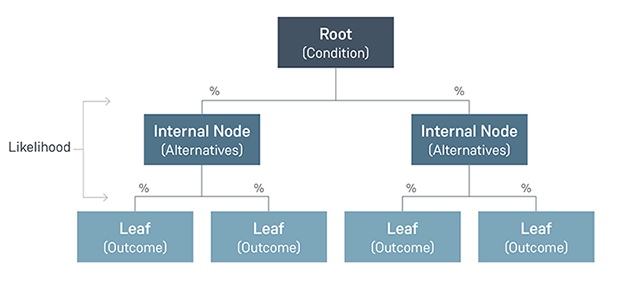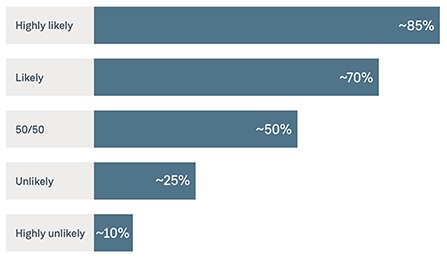- within Corporate/Commercial Law topic(s)
Decision trees in disputes
"Almost all disputes are about money and ego...rarely in that order"
Dispute resolution involves a series of decisions: Which lawyer does the party engage? Which barrister? In which forum should the claim be brought? Which witnesses should be called? And so the list goes on. Whilst managing a dispute is very different from the decision to build a new factory, or enter a new market, ultimately entering into a dispute (or deciding whether to defend one's position) involves a number of strategic and tactical choices and is essentially an investment decision: how much time, money and effort am I prepared to invest to seek redress?
Whilst disputes are fundamentally a series of investment decisions, the logic behind those decisions is often cloaked in and clouded by ego and emotion.
In addition to the ego and emotion of the parties to the dispute, it is important to remember that solicitors, barristers and other professionals can also bring their egos and emotions into the process. Even when ego and emotion are kept in check - and despite all the talk of "early case assessment"- rarely is a robust framework used to help structure these decisions and communicate changes over time.
Decision trees are one tool that can provide such a framework and structure.
What is a decision tree?
Decision trees are easy to follow, easily understood flow-chart like diagrams which set out a visual, logical representation of the possible outcomes of a series of related issues and decisions. Their use as a decision-making tool in planning strategy makes them ideal for use in dispute resolution.
The first question of the tree is the "root" or "root node", from which lines are drawn to represent each potential option. If each option leads to a further question or decision, then each option leads to an 'internal node", until each choice or outcome has been considered, and culminates in a final outcome or "leaf node".

Decision trees in disputes
The first step in managing a dispute process is the identification of the key issues driving the final outcome, normally in terms of quantum. A great deal of value can be obtained from this process alone: lawyers and clients need to have a realistic assessment of the amount of money at stake at an early stage of the process. Once each decision point and every potential outcome has been identified and recorded, the likelihood and value of each different event need to be estimated.
Likelihood
Our experience is that legal teams and their clients are often sceptical, or at least nervous, of putting percentage chances against different potential outcomes. However, they do – perhaps subconsciously – tend to put things into one of five different categories; Highly likely, Likely, 50/50, Unlikely and Highly unlikely. These categories can be translated into chances expressed as percentages.
Most lawyers would hesitate to say that anything in a dispute is certain – a witness may have a bad day in the witness box, new case law may emerge, or the judge or arbitrator may make an error of law. So even something that is deemed 'highly likely' should probably only have an 85%-90% chance applied to it. Conversely, even something that is deemed "highly unlikely' is rarely considered as having absolutely no chance of occurring, so perhaps can be considered a, say, 10% chance. Then, consider the "50/50" and this third category is the middle of the five categories. The two remaining categories of "likely" and "unlikely" sit between the middle ground and each end of the assessment spectrum, and applicable percentages may be considered to be say 70% and 25% respectively.

Values
In terms of the estimated values attributable to each potential outcome, consideration should be made of the costs or gains associated with each event, including delays, taxation, and court interest where appropriate.
Outcomes
Once all alternatives have been considered, documented, and outcomes calculated (being likelihood x value), based on the information available, the client and its advisors can determine which course of action at any particular outcome point will yield the most preferable result. In some cases, the ultimate decision may not be driven by the final outcome on damages, but on what will occur in relation to costs based on the duration of the process.
Benefits of Decision Tree Analysis
Risk identification and mitigation
Decision tree analysis, and in particularly the associated documentation and thinking behind that analysis, can also help the legal team to identify and mitigate risks, as it allows them to:
- Communicate early and frequently;
- Clearly explain risks and costs of different options and approaches; and
- Ensure expectations are clearly understood.
Scenario Modelling
Especially in the early stages of a matter, it may not be clear which scenario (or set of scenarios) is most likely. Whilst discount rates can often deal with estimation risks in considering potential cash flows, there are some situations where binary inflection points may need other approaches.
For example, it is common for non-compete clauses to have cascading alternative periods – 24 months, or if not then 18 months, or if not then 12 months etc. Each of these can be seen as a different scenario which should be modelled separately, rather than modelling, say, the longest (or shortest) period and then trying to use the discount rate to account for the likelihood of being successful for each time period. Depending on the circumstances of the case, the legal team may have a view that one or other of these scenarios has a greater likelihood of being found.
Sensitivity Analysis
It is important to understand how the likely outcome from a matter is sensitive to changes in a key input. Modelling of changes in each assumed input can allow the legal team to understand which inputs are likely to have the greatest impact on the outcome. Repeating a decision tree to test the veracity or impact of a minor change to each assumption will identify key inflexion points on which a matter may hang. If, for example, a movement of 5% in probability causes a significant change to the ultimate outcome, attention needs to be paid to that variable to understand and refine it as much as possible. Again, this may include further investment, for example, on discovery, or seeking the opinion of another expert or counsel.
Identification of differences
Similar to how they support sensitivity analysis, decision trees help to identify and show the relationships between different elements – legal questions, evidentiary facts and assumptions from factual witnesses and expert opinions. They can help to document the extent to which those have an impact on a likely outcome, thereby better informing the decision of where investment will derive greatest "bang for buck".
Stakeholders in a dispute will view the different elements and associated risks in different, sometimes conflicting ways: the view of the party providing capital may differ from that of the party seeking justice, and again from that of an expert. Decision trees allow for the identification and articulation of differing opinions or assumptions within and between the client team and its professional advisors, allowing them to be dealt with and agreed upon before the matter is too far progressed. Is the difference between two opinions down to the question asked, or something else, like an assumption? If it seems to be a function of which question to ask, investment might be made in requesting senior counsel to assess its legality and/or working with a consulting expert. If it appears to relate to an assumption, investment might be made in assessing the merits of that assumption, which might require further evidence from witnesses of fact, or more investigations by an expert.
Clarity and Structure
Decision trees provide a formal structure which facilitates communication within a team and to other stakeholders as to why a particular course of action is considered appropriate at a particular point in time. To a large extent, people are visual creatures and decision tree diagrams cut through the clutter of words, clearly laying out paths, options, likelihood, and outcomes.
Repeatable
The reality is that - with very limited exceptions - disputes are run only once in any jurisdiction, and usually only in one jurisdiction. It is essential that the legal team and clients are clear on the range of values that may arise from the various scenarios, and in particular ensure that the client can afford the uppermost limit of that range. A decision tree is a form of probability adjusted cash flow analysis, which can be repeated over the course of a dispute. As things change, determinations are made, or other information comes to light, the framework provided by a decision tree can be revisited and updated to assess the impact of a change from an investment return, and decision path perspective.
Defensible proportionality
As courts increasingly turn their mind to whether legal costs are proportionate in the circumstances , decision trees demonstrate how such costs were assessed.
If there is a challenge as to proportionality, a clearly laid out decision tree can provide a defensible, formal assessment to justify why a particular course of action was determined to be proportionate at a point in time.
If there is no assessment of the likelihood of particular scenarios and the values of those scenarios, then it is difficult to see how lawyers can demonstrate why particular aspects of costs were, at the time, considered proportionate.
Proportionality
Section 24 of the Civil Procedure Act 2010 obliges those to whom the overarching obligations apply, to use reasonable endeavours to ensure that legal costs and other costs incurred in connection with the civil proceeding are reasonable and proportionate to the complexity or importance of the issues and amount in dispute.
Section 24 imposes a continuing obligation. Parties and the lawyers must regularly examine during the course of a proceeding whether they have used 'reasonable endeavours' to assess if there is a proportionate relationship between the costs and the value in dispute (McCarthy v Camil Holdings Pty Ltd [2016] VSCA 235 at [57]-[60]; Actrol Parts Pty Ltd v Coppi [2015] VSC 758 at [61]).
Decision tree analysis does not replace robust legal analysis and advice, however it is one of a number of tools that can be used to ensure that pro-active and comprehensive risk assessment and project management techniques are brought to bear on the dispute process.
Decision trees, and the thinking behind them, provide a structure, framework, and communication tool within disputes to help assess the merits of each decision. They can also help to identify, and possibly reduce or eliminate, the extent to which emotion and ego may be playing a part.
Decision trees - and perhaps just as importantly, the systematic thinking required to populate them - can help those involved clearly show the proportionality of tactical and strategic decisions made throughout the process, and effectively communicate reasons for changes in approach throughout the dispute.
The content of this article is intended to provide a general guide to the subject matter. Specialist advice should be sought about your specific circumstances.
[View Source]

